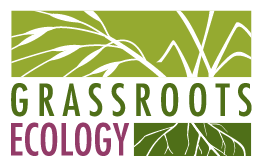Native Plant of the Month: California Native Bunchgrasses
California is known for its rolling golden hills and vast valley grasslands. In the summer, these iconic landscapes are covered with the dry stalks of annual grasses, which wave gracefully in the wind beneath the majestic branches of oaks.
But did you know that most grass in California’s grasslands today are invasive? Species like slender oats (Avena barbata), ripgut brome (Bromus diandrus), and foxtail barley (Hordeum murinum) were brought by settlers over the past few centuries, either accidentally or intentionally for forage. With the help of excessive cattle grazing, the loss of native animals, and the removal of indigenous stewardship, many introduced grasses became invasive and eventually displaced over 99% of native plant cover in grasslands across the State.
About California Native Bunchgrasses
Amid the sea of invasive grasses, pockets of our native California fescue, blue wild rye, and purple needlegrass remain. Indigenous Californians have tended to and used native grasses for food and basketry material since time immemorial, and they continue these practices to this day.
The most common invasive grasses in California are annual, meaning they die in the dry summer season after dropping their seeds. By contrast, most California native grass species are perennial and can live for years or even decades, developing deep root systems that stabilize soil and store carbon. In addition, many are bunchgrasses, which means they tend to grow in individual clumps with space in between for other plants to grow.
Growing California Native Bunchgrasses at Home
California is home to approximately 300 native grass species, which grow in a variety of conditions. Below are a few bunchgrasses that are often planted in gardens:
California fescue (Festuca californica) has graceful blue-green leaves and thrives in dappled shade or sun.
California melic grass (Melica californica) does well in partly shaded understories or in well-drained rock gardens.
California brome (Bromus carinatus) is a fast-growing, short-lived species that readily reseeds and can help compete with weeds.
Blue wildrye (Elymus glaucus) is a tall and slender grass that can be used as an accent plant.
Purple needlegrass (Stipa pulchra), our state grass, loves full sun and produces nodding, purple-tinged seeds with long awns in the spring.
Most bunchgrasses can survive without supplemental water once established, but occasional irrigation can help them stay more lush and green through the dry season. In the late summer to fall, rejuvenate your native grasses and stimulate new growth by removing dead leaves and spent flower stalks. You can do this either with garden clippers or simply by running your hands through the grass and gently pulling out the old material.
Where to find California Native Bunchgrasses and Other Native Plants
Our nursery grows native plants like bunchgrasses using seeds and cuttings carefully sourced from local watersheds. See our latest inventory for online sales here:
Our nursery is thrilled to be a partner of Bloom! California. Along with over 100 other nurseries around the state, our nursery is offering 11 select native plant groups—including grasses—that bring California’s unique beauty into your garden, create pollinator habitat, restore nature in the urban landscape, and support water conservation. Learn more at bloomcalifornia.org!
References
Ornamental Grasses (Bloom! California)
California Native Bunchgrasses (California Native Plant Society)
Grassland Facts (California Native Grasslands Association)
California Native Grasslands: A Historical Perspective (University of California Agriculture and Natural Resources)
Systematics of California Grasses (University of California Press)
By Stanley Gu, Ecologist




